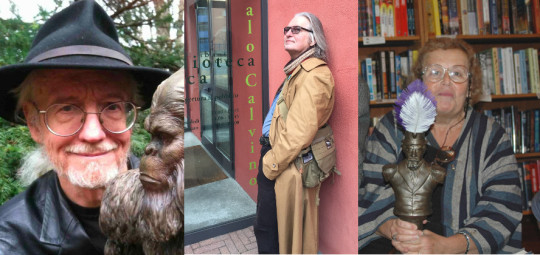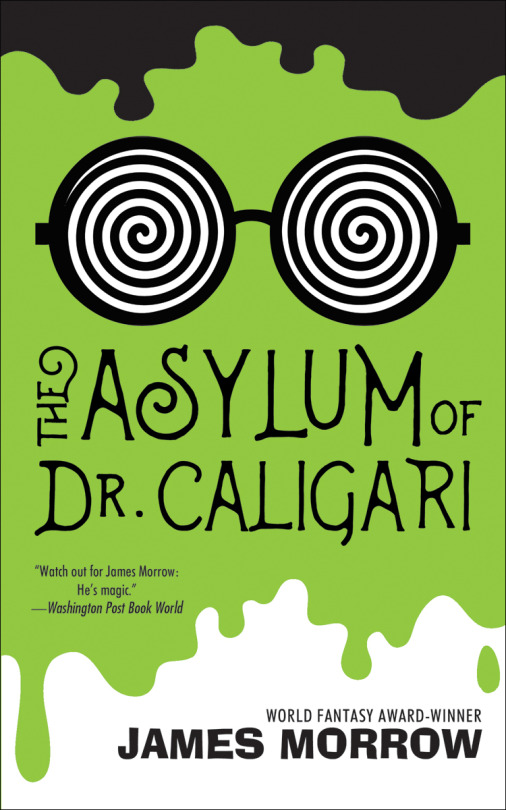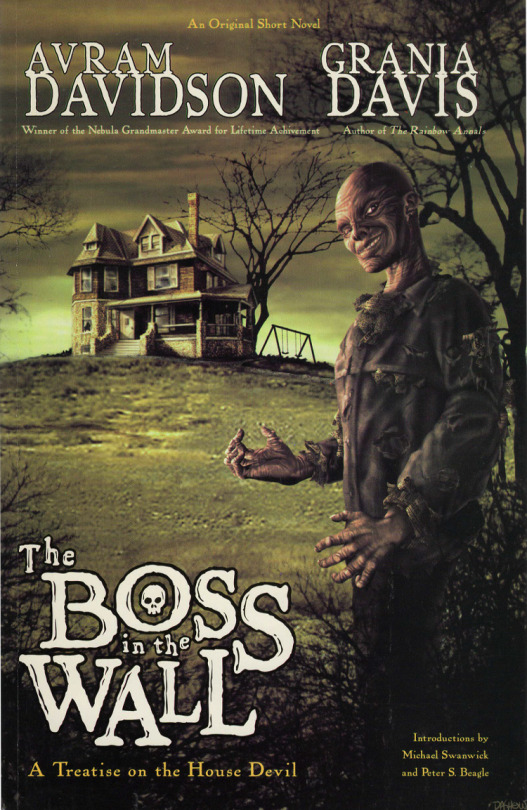Tachyon tidbits featuring James Morrow, Bruce Sterling, and Grania Davis
The latest reviews and mentions of Tachyon titles and authors from around the web.

James Morrow, Bruce Sterling, and Grania Davis (Photo: Jeremy Lassen/LOCUS)
At STRANGE HORIZONS, Matt Colborn praises James Morrow’s forthcoming THE ASYLUM OF DR. CALIGARI.
In his latest novel, James Morrow tackles the seductive but repugnant nature of war. Morrow tackled this theme in his anti-nuclear fable THIS IS THE WAY THE WORLD ENDS (Henry Holt, 1986), in which the progenitors of a Third World War are put on trial for their crimes by the “unadmitted,” undead people who would have lived had the nuclear holocaust not occurred. THE ASYLUM OF DR. CALIGARI, by contrast, takes inspiration from the silent German feature DAS CABINET DES DR. CALIGARI (Robert Wiene, 1920); the resulting novel reworks many of the themes implicit in the film in a way that is relevant to our Brave New Era of strident nationalism.
<snip>
The invocation of the visual style of the movie is significant. At Yale’s Modernism Lab, Merrick Doll notes that its expressionist style was intended to evoke impulsive emotional power, as opposed to intellectual or aesthetic appreciation. Morrow’s novel, too, is intensely concerned with the aesthetic effects of art. Indeed, its protagonist is a talent-free graduate of the Pennsylvania Academy of Fine Arts, Francis Wyndham, who on the eve of World War One moves to Paris under the conviction that his “avant-garde images” are destined to “cure the complacency of the bourgeoisie.” He is thrown down a stairway by Picasso, rejected by Duchamp and Rousseau, and finally sent to Caligari’s asylum by André Derain, to act as an art therapy tutor to the inmates.

Nevertheless, ideas—aesthetic—are powerful and can manipulate opinion. In THIS IS THE WAY THE WORLD ENDS, Morrow suggests that the architects of nuclear death are guilty of entertaining the “bad ideas” that, in the novel, facilitate Armageddon. ASYLUM in many ways makes the same accusation: that cynical war “profiteers” like Caligari, the propagators of bad ideas, are culpable for their impacts, despite their denials. In an age in which warmongering hate-speech once more seems to have become almost acceptable, this is a charge we perhaps need to take very seriously indeed.
You might also argue that ASYLUM trades upon a rationalist myth that people need to be “deranged” or “delusional” to do bad things, which can seem somewhat of an oversimplification. To read Morrow’s work as a commentary on the recurrent, destructive, and eroticized insanities that seem to perennially infect the human animal, however, is also to make it seem as unfortunately contemporary as ever.

Cory Doctorow for the CBC lists 7 books he loves including Bruce Sterling’s PIRATE UTOPIA.
The novella PIRATE UTOPIA is a zippy, quick read by Bruce Sterling, who is my mentor and a wonderful cyberpunk writer. Bruce set out to write an alternate history of the Free State of Fiume (now part of Croatia), which was this island off the coast of Italy. Between 1920 and 1924, Fiume was this weird futuristic home of all of these strange movements that came together. They built a factory that made torpedoes, so they were arms dealers to the world.
Bruce imagines continuity for Fiume, in which it continues into the Second World War. His protagonist is this guy who goes by the moniker the Pirate Engineer, whose surrounded by a cast of characters including the Prophet, the Art Witch and the Ace of Hearts. It’s a story about weird extreme politics, which makes it a contemporary novel, despite the fact that it’s set in this odd moment. It’s about the twin excitement and shabbiness of futurism and fascism. It’s a wonderful book that will leave you scratching your head and laughing aloud and marvelling at some of the verbal pyrotechnics of someone who is steeped in technology, design, history and politics.
For THE NUTMEG POINT DISTRICT MAIL (Vol. XVII No. 1), editor Henry Wessells remembers Grania Davis.
Grania Eve Kaiman was born 27 July 1943 in Milwaukee, Wisconsin, and was raised in Hollywood, California. She was married to Avram Davidson in a traditional Jewish ceremony in the home of Damon Knight and Kate Wilhelm in Milford, Pennsylvania. Their son Ethan was born in November 1962. They lived briefly in New York City and Milford before moving to Amecameca, Mexico, in the spring of 1963. Avram described the town: “a narrow-gauge steam railroad whistles its way through burro-iferous streets which may, conceivably, have been paved during the Juarez Administration or the reign of Maximilian which interrupted it; and over choo-choo train, donkeys, muddy lanes, sixteenth-century church, serape’d Indios and all, broods the great blue bulk of Popocatepetl.” During this time (long before overnight delivery services), Avram was editor of the Magazine of Fantasy and Science Fiction.
In her essay “Water from a Deep Well”, Eileen Gunn wrote, “In the spring of 1964, Avram and Grania reluctantly concluded that their marriage was not a compatible one. In the early summer, Grania moved to Oakland in the San Francisco Bay area, where she and Avram each had many friends, primarily writers and readers of science fiction. Avram followed a few months later with Ethan. He found a place nearby in Berkeley, and he and Grania remained friends, sharing childcare responsibilities, and later collaborating on stories and novels.” Grania had begun a correspondence with Philip K. Dick while in Mexico — he wrote great laters to her and Avram (most of these were sold in 2008 and are now in a private collection), and she became involved with him for a time.

At the time of Avram Davidson’s death, only two of his books were in print from Owlswick Press. Grania proved a tireless champion of his work. I first met Grania in person when she came to New York to meet with editors to discuss a collection of Avram Davidson stories, eventually published by Tor as The Avram Davidson Treasury (1998). Grania soon enlisted me to assist in what became an Avram Davidson revival. During trips to the Bay area, I would visit her, sometimes in San Rafael and occasionally at Japanese restaurants in San Francisco. Four further collections of Davidson’s stories and the last Vergil Magus novel were published from 1999 to 2005, all co-edited by Grania. In June 2005, Texas A & M University acquired the Avram Davidson Archive from the Estate of Avram Davidson through a gift/sale agreement, thus ensuring a permanent home for Davidson’s manuscript materials and extensive correspondence. The Archive complemented a substantial catalogued collection of material from the early phase of Davidson’s career already held in the Science Fiction and Fantasy Research Collection. Deals were struck for the publication of the Davidson backlist as print on demand books, e-bookes, and audio books.
In recent years, Grania organized a collection of her own short stories, Tree of Life, Book of Death (2013), and edited a volume of collaborations between Avram and Ethan Davidson. She regularly attended science fiction conventions: I remember running into her in a corridor at the World Fantasy Convention in San José. We last saw each other in person during LonCon 3 (2014).
The Nutmeg Point District Mail and the Avram Davidson Society salute a friend of many years.
For more info on THE ASYLUM OF DR. CALIGARI, visit the Tachyon page.
Cover by Elizabeth Story
For more info on PIRATE UTOPIA, visit the Tachyon page.
Cover by John Coulthart
For more info on THE BOSS IN THE WALL, visit the Tachyon page.
Cover by Michael Dashow
